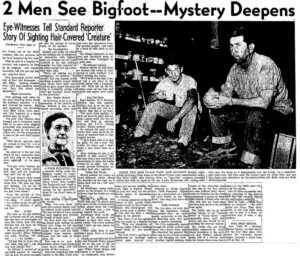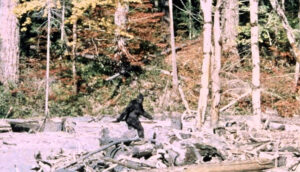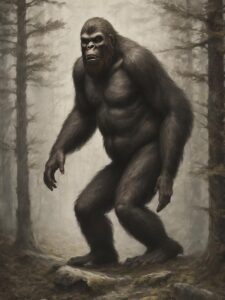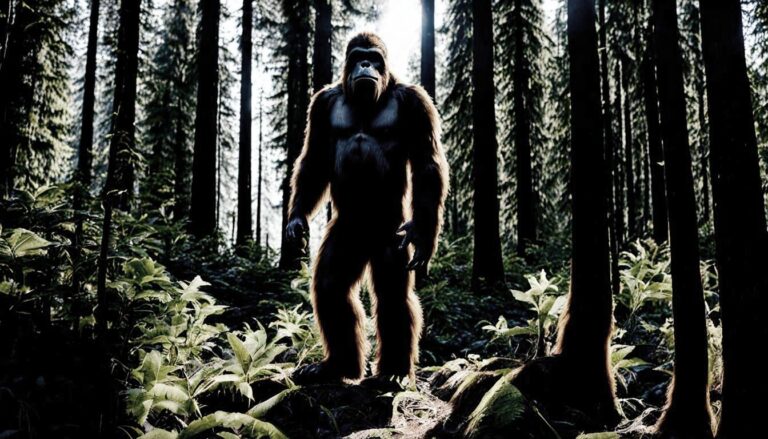Table of Contents
The term “Bigfoot” became popular in the mid-20th century, and the creature has since become a part of North American folklore. Despite numerous reported sightings and a plethora of anecdotal evidence, there is no scientific proof of the existence of Bigfoot. Skeptics attribute most sightings to misidentifications of known animals, hoaxes, or a combination of both.
The legend of Bigfoot has inspired a significant cultural phenomenon, with numerous books, documentaries, and even a subgenre of cryptozoology dedicated to the search for this elusive creature. Various Native American traditions also include stories of similar creatures, adding to the mystique surrounding the legend of Bigfoot.
First American Records
The first American records of Bigfoot, or similar creatures, can be traced back to various Native American traditions and folklore. Indigenous peoples across North America have long shared stories of large, hairy, and elusive beings that inhabit the wilderness. These creatures go by different names in different tribal traditions.
Among these indigenous accounts are stories of creatures like the “Sasquatch” in the Pacific Northwest, “Skookum” in the Cascade Range, and “Oh-Mah” in the Rocky Mountains. The details and names vary among tribes, but the common theme is that of a large, often hairy, humanoid creature that dwells in remote, wooded areas.
The term “Bigfoot” itself gained prominence in the mid-20th century. One of the earliest documented instances occurred in 1958 when a construction worker named Jerry Crew discovered large, mysterious footprints at a construction site in Bluff Creek, California. Crew and his coworkers coined the term “Bigfoot” to describe the creature that they believed had left the tracks.
This discovery, along with subsequent reports of sightings and footprints, led to increased public interest in Bigfoot. The legend gained further attention in the 1960s with the infamous Patterson-Gimlin film, which purportedly captured a Bigfoot on camera in the Bluff Creek area. The film’s authenticity remains a subject of debate.
While Native American traditions provide a historical context for the legend of large, hairy beings, it was the mid-20th-century reports and the coining of the term “Bigfoot” that brought the creature into mainstream American consciousness. Since then, Bigfoot has become an enduring part of American folklore, captivating the imagination of people around the world and inspiring numerous expeditions and investigations in search of this elusive cryptid.
How Bigfoot Came to Be Named
The term “Bigfoot” came into popular usage in the mid-20th century, and its origin is often attributed to a series of events in the late 1950s.
In 1958, a construction worker named Jerry Crew discovered large, mysterious footprints at a construction site in Bluff Creek, California. These footprints were reported to be approximately 24 inches long and 8 inches wide, resembling the impression of a large, human-like foot. Crew, along with his coworkers, cast the prints in plaster and made the details public.
The Humboldt Times, a newspaper in Eureka, California, covered the story, referring to the mysterious track-maker as “Big Foot” in a headline. The term was used as two separate words in the original headline.
As the story gained traction, the term “Bigfoot” caught on and began to be widely used to describe the elusive, large, and hairy creature that was believed to have left these footprints. Over time, the name became synonymous with the cryptid itself.
Notably, the name “Bigfoot” is specific to North American folklore, particularly in the Pacific Northwest region where numerous sightings and reports of such a creature have been documented. Other regions may have their own names for similar creatures, such as the Yeti in the Himalayas or the Yowie in Australia.
The coining of the term “Bigfoot” played a crucial role in popularizing the legend and contributing to the creature’s status as a cultural phenomenon. The term has since become ingrained in discussions about cryptids and cryptozoology.
What Does Bigfoot Look Like?

Descriptions of Bigfoot vary widely, as the creature is part of folklore and there is no scientific evidence to provide a standardized depiction. However, there are some commonalities in the descriptions provided by those who claim to have seen Bigfoot or encountered evidence of its presence. Here are some general characteristics often associated with Bigfoot:
Size: Bigfoot is commonly described as a large and towering creature, with reported heights ranging from 7 to 10 feet or even taller. It is often portrayed as having a robust and muscular build.
Covered in Hair: Bigfoot is typically depicted as being covered in fur or hair, which is described as dark brown or black. The hair is often reported to be long and shaggy, providing a level of insulation.
Face and Features: Witnesses often mention that Bigfoot’s face is hidden beneath the hair, making facial features difficult to discern. However, some reports suggest a prominent brow ridge and a relatively flat face.
Humanoid Appearance: Despite its ape-like features, Bigfoot is often described as having a more human-like appearance, including the ability to walk upright on two legs. Its gait is sometimes described as being more like that of a human than an ape.
Footprints: The size and shape of footprints attributed to Bigfoot are notable features. Reports often describe footprints ranging from 15 to 24 inches in length, resembling an enlarged human foot with five toes.
Nocturnal Behavior: Many reported sightings suggest that Bigfoot is nocturnal and tends to avoid human contact. Witnesses often describe it quickly retreating into the forest when spotted.
Does Bigfoot Show Signs of Intelligence?
The question of Bigfoot’s intelligence is a matter of speculation and interpretation, as there is no scientific evidence supporting the existence of Bigfoot. Reports and anecdotes about Bigfoot’s behavior vary, and descriptions range from a more animalistic and elusive nature to accounts that suggest a level of intelligence.
Proponents who believe in the existence of Bigfoot often attribute certain behaviors to a perceived intelligence. Some reports describe the creature exhibiting seemingly deliberate actions, such as avoiding humans, displaying curiosity, or even engaging in what some interpret as strategic behavior to evade detection.
On the other hand, skeptics argue that reported behaviors can be attributed to various factors, such as the natural instincts of known animals, misidentifications, hoaxes, or the influence of environmental conditions.
In the absence of concrete evidence, it is challenging to make definitive statements about Bigfoot’s intelligence. Scientifically rigorous studies, including the collection of physical evidence or the observation of consistent behaviors, are necessary to draw any conclusions about the existence and characteristics of such a creature.
Until there is conclusive scientific evidence, the question of Bigfoot’s intelligence remains speculative and is often influenced by individual beliefs, interpretations of anecdotal accounts, and the broader context of the folklore surrounding this legendary creature.
Famous Sightings The 1958 Story

One of the most notable incidents in the early history of Bigfoot sightings is associated with a series of mysterious footprints discovered in 1958. This event played a pivotal role in bringing the term “Bigfoot” into popular usage.
In August 1958, a construction worker named Jerry Crew was working on a road-building project in Bluff Creek, a remote area in Humboldt County, California. Crew and his crewmates stumbled upon a set of large, unusual footprints in the freshly laid asphalt. The footprints measured about 16 inches in length and 7 inches in width, resembling the impression of a large, human-like foot.
Intrigued by the discovery, Crew made casts of the footprints and brought them to the attention of his coworkers and employer. The news of the mysterious footprints soon reached the local media. The Humboldt Times, a newspaper in Eureka, covered the story and, in a headline, referred to the unknown creature as “Big Foot.” Interestingly, in the original headline, “Big Foot” was written as two separate words.
The term “Bigfoot” caught on quickly and became associated with the elusive creature believed to have left these tracks. Following this incident, numerous reports of sightings and encounters with Bigfoot or Sasquatch were publicized, contributing to the creature’s status as a cultural phenomenon.
It’s important to note that while the 1958 discovery of large footprints played a role in popularizing the term “Bigfoot,” the creature itself had been a part of Native American folklore and regional legends long before this event. The incident in Bluff Creek, however, marked a turning point in bringing Bigfoot to the forefront of public attention.
Famous Sightings The Patterson-Gimlin Film

One of the most iconic and controversial pieces of evidence in the realm of Bigfoot sightings is the Patterson-Gimlin film. Filmed in 1967, the footage is often referred to as the Patterson-Gimlin film or simply the “PGF.”
Here are the key details about this famous sighting:
Date and Location: The Patterson-Gimlin film was recorded on October 20, 1967, in the Bluff Creek area of Northern California. Roger Patterson and Robert “Bob” Gimlin, two amateur filmmakers, were in the region specifically to investigate recent reports of Bigfoot sightings.
The Film: The film shows a creature, commonly referred to as “Patty,” walking through a clearing in the forest. The subject appears to be a large, bipedal, and hairy creature resembling the descriptions of Bigfoot. The film is approximately 59 seconds long.
Controversy: The Patterson-Gimlin film is one of the most debated pieces of evidence in the study of Bigfoot. Some view it as compelling evidence of the creature’s existence, citing details such as the natural movement of the subject and the anatomical features visible in the footage. Others argue that it could be a hoax, with claims ranging from the use of a person in a costume to elaborate filmmaking techniques.
Support and Skepticism: The film has supporters within the cryptozoology community who consider it a genuine documentation of a Bigfoot encounter. However, skepticism persists, and the debate over the film’s authenticity has continued for decades.
Legacy: Despite the ongoing controversy, the Patterson-Gimlin film remains one of the most well-known pieces of evidence associated with Bigfoot. It has played a significant role in popular culture and has been the subject of documentaries, investigations, and discussions within the cryptozoological community.
While the Patterson-Gimlin film has not provided conclusive proof of Bigfoot’s existence, it remains a crucial part of the broader narrative surrounding this elusive creature.
Creatures That Could be Related to Bigfoot
The concept of Bigfoot, also known as Sasquatch, exists within the realm of cryptozoology, which explores the existence of creatures that are not officially recognized by mainstream science. While there is no scientific evidence supporting the existence of Bigfoot, various legends and anecdotal reports describe similar mysterious creatures in different parts of the world. Here are a few of them:
Yeti (Abominable Snowman):
The Yeti is a legendary ape-like creature said to inhabit the Himalayan mountain range. Similar to Bigfoot, the Yeti is described as large, covered in hair, and walking upright. Reports often come from regions like Nepal and Tibet.
Almas: The Almas is a cryptid reported in Central Asia, particularly in the Caucasus and the Pamir Mountains. Descriptions vary, but it is often depicted as a large, hairy, human-like creature.
Yowie: The Yowie is an Australian cryptid reported in various regions, including the forests and mountains. Descriptions range from an ape-like creature to a more human-like figure, with reports spanning many decades.
Skunk Ape: The Skunk Ape is a cryptid reported in the southeastern United States, particularly in Florida, Louisiana, and Arkansas. Descriptions often involve a large, ape-like creature with a foul odor.
Mande Barung: The Mande Barung is reported in the remote forests of northeastern India and Bangladesh. Descriptions include a large, hairy, upright-walking creature.
Orang Pendek: The Orang Pendek is a cryptid reported in the dense rainforests of Sumatra, Indonesia. Descriptions vary, but it is often described as a short, upright-walking creature resembling a small hominid.
Mapinguari: The Mapinguari is a legendary creature reported in the Amazon rainforest of South America, particularly in Brazil and Bolivia. Descriptions include a large, hairy, and sometimes cycloptic creature.
Explanation of the Myth

The myth of Bigfoot, also known as Sasquatch, is rooted in the realm of cryptozoology—the study of creatures whose existence is not scientifically proven. While the term “Bigfoot” gained popularity in the mid-20th century, the creature has deep roots in the folklore and traditions of various indigenous peoples in North America.
Origins in Native American Folklore: The concept of large, hairy, and elusive creatures resembling Bigfoot is present in the oral traditions of numerous Native American tribes. Various tribes have different names and descriptions for these beings, such as Sasquatch, Skookum, or Oh-Mah. These creatures are often portrayed as part of the natural world, residing in remote wilderness areas.
Modern Legend: The modern legend of Bigfoot gained momentum in the late 1950s and early 1960s, partly due to a series of reported sightings and discoveries of large footprints. The term “Bigfoot” itself was popularized by the media following the discovery of such footprints, notably in Bluff Creek, California, in 1958.
Characteristics of Bigfoot: Bigfoot is typically described as a large, ape-like or humanoid creature, covered in hair, and walking upright on two legs. Descriptions vary, but common features include a powerful build, broad shoulders, and a head that appears more human-like than that of an ape.
Sightings and Anecdotes: Reports of Bigfoot sightings come from various parts of North America, with concentrations in the Pacific Northwest. Witnesses often describe fleeting encounters, large footprints, and, in some cases, interactions with the creature. Despite numerous claims, there is no scientifically verified evidence of Bigfoot’s existence.
Cultural Impact: Bigfoot has become a cultural phenomenon, inspiring a vast array of books, documentaries, films, and television shows. It has also become a subject of interest in the field of cryptozoology, with researchers and enthusiasts conducting expeditions in hopes of finding conclusive evidence.
Scientific Skepticism: Mainstream science remains skeptical of the existence of Bigfoot due to the lack of empirical evidence, such as DNA samples, bones, or clear photographs. Many reported sightings are attributed to misidentifications of known animals, hoaxes, or the play of shadows and light in forested environments.
The myth of Bigfoot, while lacking scientific substantiation, continues to captivate the public imagination, sparking debates, investigations, and fueling the enduring mystery surrounding this elusive creature. Whether a mythical figure or a yet-to-be-discovered species, the legend of Bigfoot persists as a cultural and cryptozoological enigma.
Bigfoot FAQ
What is Bigfoot?
Bigfoot, also known as Sasquatch, is a legendary and elusive humanoid creature often described as large, hairy, and bipedal. It is a prominent figure in cryptozoology, with reported sightings and folklore primarily in North America.
Where is Bigfoot said to be found?
Sightings of Bigfoot have been reported in various regions, but it is most commonly associated with the Pacific Northwest of the United States and Canada. Reports also come from other wooded and mountainous areas across North America.
What are the common characteristics of Bigfoot?
Bigfoot is typically described as a large, ape-like creature with human-like features. It is said to be covered in hair, walk upright on two legs, and possess a robust build. Details vary among reported sightings.
Are there different names for Bigfoot?
Yes, various indigenous tribes have different names for similar creatures, such as Sasquatch, Skookum, Oh-Mah, and more. The name "Bigfoot" gained popularity in the mid-20th century.
Is there any scientific evidence of Bigfoot's existence?
No scientifically accepted evidence supports the existence of Bigfoot. While there are numerous reported sightings and footprints, none have been conclusively linked to an unknown species.
What is the Patterson-Gimlin film?
The Patterson-Gimlin film is a short piece of footage recorded in 1967 that purportedly shows a Bigfoot walking in the woods. It is one of the most famous pieces of evidence in the study of Bigfoot but remains controversial.
Are there other creatures similar to Bigfoot in different cultures?
Yes, various cultures have legends of large, hairy, humanoid creatures. Examples include the Yeti in the Himalayas, Yowie in Australia, and Almas in Central Asia.
Why is Bigfoot considered a cryptid?
A cryptid is a creature whose existence is suggested but not proven by scientific evidence. As there is no conclusive evidence of Bigfoot, it falls into the category of cryptids studied by cryptozoologists.
What is the origin of the name "Bigfoot"?
The term "Bigfoot" gained popularity in 1958 after construction worker Jerry Crew found large footprints in Bluff Creek, California. The discovery was covered by the media, and the term became widely recognized.
Is there a cultural impact of Bigfoot?
Yes, Bigfoot has had a significant impact on popular culture. It has inspired numerous books, films, documentaries, and even dedicated research expeditions. It remains a symbol of mystery and fascination.
How tall is Bigfoot supposed to be?
Reported heights of Bigfoot vary, with estimates ranging from 7 to 10 feet or even taller. Witness accounts often describe it as towering over an average human.
Are there any reported sounds associated with Bigfoot?
Some Bigfoot reports include descriptions of vocalizations, such as howls, screams, or wood knocks. These purported sounds contribute to the lore surrounding the creature.
Are there specific regions with more Bigfoot sightings?
The Pacific Northwest, including states like Washington and Oregon, is often cited as a hotspot for Bigfoot sightings. However, reports come from various wooded and mountainous areas across North America.
Has anyone claimed to have captured a Bigfoot?
There have been occasional claims of people capturing or possessing a Bigfoot, but none of these claims have been substantiated with credible evidence. Many alleged captures have turned out to be hoaxes.
How does Bigfoot differ from other cryptids?
Bigfoot is distinguished by its humanoid appearance, typically described as resembling a large, upright-walking ape. Unlike some cryptids with fantastical features, Bigfoot is often portrayed as a more realistic, albeit elusive, creature.
Are there organizations dedicated to researching Bigfoot?
Yes, several organizations and researchers, often associated with cryptozoology, focus on investigating reported Bigfoot sightings and collecting evidence. However, mainstream scientific organizations generally do not recognize their efforts.
Has DNA evidence ever been claimed to belong to Bigfoot?
Some individuals have claimed to possess DNA evidence of Bigfoot, such as hair samples or scat. However, these claims have faced scrutiny, and none have provided conclusive proof of Bigfoot's existence.
Are there cultural explanations for Bigfoot in indigenous traditions?
Many Native American tribes have folklore and traditions that include large, hairy, and mysterious beings similar to Bigfoot. These creatures often have spiritual significance and are woven into cultural narratives.
Why do people continue to search for Bigfoot despite the lack of scientific evidence?
The search for Bigfoot is fueled by a combination of genuine curiosity, the desire for discovery, and the cultural allure of mystery. It has become a part of popular culture, inspiring enthusiasts and researchers alike.
Has Bigfoot ever been depicted in literature and popular media?
Yes, Bigfoot has been featured in numerous books, films, TV shows, and documentaries. Its depiction ranges from terrifying creature to gentle forest dweller, contributing to its multifaceted cultural image.
Are there any hoaxes associated with Bigfoot sightings?
Yes, there have been various hoaxes related to Bigfoot, including fabricated footprints, blurry photographs, and staged videos. Hoaxes contribute to skepticism and hinder serious research efforts.
Do people actively organize expeditions to search for Bigfoot?
Yes, organized expeditions and research efforts are conducted by enthusiasts and cryptozoologists. These often involve field investigations, interviews with witnesses, and the use of technology like trail cameras and audio recording equipment.
Are there any rewards offered for proof of Bigfoot's existence?
At various times, individuals and organizations have offered rewards for credible evidence of Bigfoot, such as clear photographs, DNA samples, or a live capture. However, no one has successfully claimed such a reward.
Are there theories about the origins of Bigfoot?
Theories about Bigfoot's origins range from it being a surviving prehistoric species to a yet-to-be-discovered primate. Others consider it a misidentification of known animals or a cultural archetype.
Has technology contributed to Bigfoot research?
Yes, advancements in technology have played a role in Bigfoot research. Trail cameras, drones, and DNA analysis are among the tools used to gather data and investigate reported sightings.
Are there any dedicated Bigfoot museums or exhibits?
Yes, there are several museums and exhibits dedicated to Bigfoot. These often showcase reported sightings, footprint casts, and other artifacts associated with the creature.
How do scientists view the study of Bigfoot?
Mainstream scientists generally view the study of Bigfoot with skepticism due to the lack of empirical evidence. The scientific method requires verifiable evidence for the acceptance of new species.
Has Bigfoot been featured in popular culture outside of North America?
Yes, Bigfoot has transcended its North American origins and has been referenced in various forms of global popular culture, including literature, movies, and television shows.
Are there any laws protecting Bigfoot or its potential habitat?
No specific laws protect Bigfoot or its habitat, as its existence is not scientifically recognized. Conservation laws may protect the natural habitats where alleged sightings occur.
How has the internet influenced Bigfoot research and discussions?
The internet has facilitated the sharing of information, reports, and theories related to Bigfoot. Online forums, social media, and dedicated websites have created virtual communities of enthusiasts and researchers
Where does Bigfoot live?
Bigfoot is said to inhabit remote, wooded areas, with sightings reported in various regions across North America. The Pacific Northwest, including states like Washington and Oregon, is often cited as a hotspot.
What does Bigfoot look like?
Bigfoot is commonly described as a large, hairy, bipedal creature with human-like features. Reports include details such as a robust build, broad shoulders, and a head that appears more human than ape-like.
What does Bigfoot eat?
There is no scientifically proven information about Bigfoot's diet. In folklore, it's often depicted as an omnivorous creature, consuming plants, berries, and possibly small animals.
How to draw Bigfoot?
Drawing Bigfoot can be approached in various ways. Artists often depict it as a large, hairy figure with human-like traits. Search for Bigfoot sketches or illustrations for inspiration.
Where is Bigfoot?
The exact location of Bigfoot is unknown and a subject of mystery. Reported sightings come from different wooded and mountainous regions across North America.
How big is Bigfoot?
Reported heights of Bigfoot vary, with estimates ranging from 7 to 10 feet or even taller. Witness accounts often describe it as towering over an average human.
When does Expedition Bigfoot return?
The return dates for television shows like "Expedition Bigfoot" can vary. Check the show's official schedule or network announcements for the latest information.
Who is Bigfoot Bae?
There is no specific individual known as "Bigfoot Bae." It's possible that the term is used colloquially or in a humorous context.
How much does Bobo on Finding Bigfoot make?
As of my last knowledge update in January 2022, I don't have specific information on the current earnings of Bobo on "Finding Bigfoot." For the latest and most accurate information, check recent sources or updates.
Where is Bigfoot from?
Bigfoot is a creature from North American folklore. Reports and sightings primarily come from the United States and Canada, with different regions having their own names for similar creatures.
Where did Bigfoot come from?
The origins of the Bigfoot legend are rooted in Native American folklore, where similar creatures have been part of oral traditions for centuries. The modern concept gained popularity in the mid-20th century, fueled by reported sightings and media coverage.





